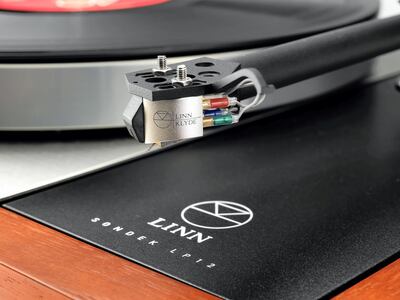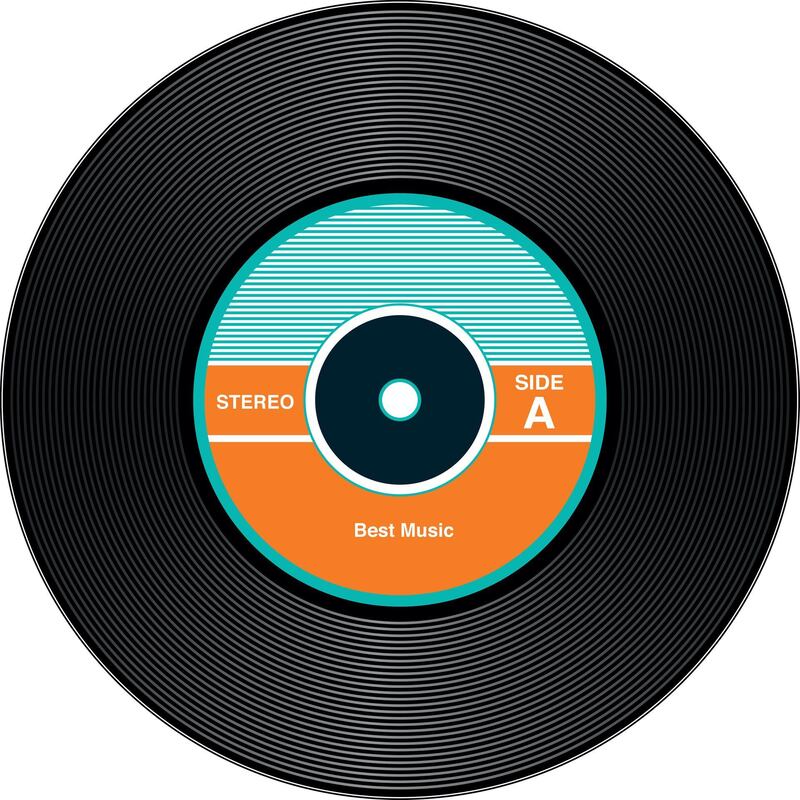Lengthy beards and waxed moustaches, checked shirts, tattoos, fixed-gear bicycles, Buddy Holly glasses, vintage shoes and 35mm film cameras with manual frame winders – love them or loathe them, hipsters have brought all these things, and more, back into vogue over the past few years. And no self-proclaimed non-conformist would even dream of listening to their Portishead or LCD Soundsystem albums on compact disc or – shudder – digital download. For true hipsters, only polyvinyl chloride records will pass muster.
But a resurgence in the popularity of vinyl cannot be explained away as simply being a part of the hipster movement. There has to be more to it than being cool, otherwise we would have already seen sales of vinyl records peak and die away. By contrast, by the end of this year, the music industry expects global vinyl sales to top US$1 billion (Dh3.7 bn) for the first time since their 1980s heyday.
Vinyl records can now be picked up in super-markets, and there are more of them on the shelves of Virgin Megastores in the UAE than there are CDs (in fact, many staff in electronics stores here have no idea what a compact disc player is). Which means, anyone with a desire to experience high-quality high fidelity has to seek out specialist audio dealers where sound is treated very seriously indeed.
Before you dismiss these stores as purveyors of money-wasting devices that add very little to your listening pleasure, consider this: what you listen to your music on can be compared to a car – a Rolls-Royce or a beat-up Nissan will get you where you want to go, but the experiences they deliver couldn’t be more different. So while we might think that MP4s downloaded in seconds to our smartphones are the way forward, the quality of the audio is often very poor, compared to how artists and their producers actually want us to hear it.
That comes down to compression of digital data. A smartphone or tablet device can store thousands of songs, along with information such as titles and album artwork. But if those audio files were the size they needed to be for perfect sound, our devices wouldn’t be able to hold more than a few dozen. And that compression usually becomes apparent when we play digital sound files through our home hi-fi equipment, which tends to highlight distortion at low volumes, a lack of depth or definition, as well as murkiness that simply shouldn’t be there.
Many of us are eager to spend huge sums of money making sure the visual aspect of our home entertainment is as good as it can get, with ultra-high-definition televisions and Blu-Ray players, but when it comes to sound, we're generally happy to accept lower standards. Yet, the beauty of vinyl records is in the way they sound and, if you want to really hear what the musicians, performers, and their engineers and producers intended you to, there really is only one option – at least according to brothers Amir and Adil Anwar, owners of Dubai Audio, and Sound & Design in Abu Dhabi.
Having set up the business 23 years ago, they have carved a reputation in the region as leading experts in all things audio, but their hearts remain defiantly analogue. Enter either of their two main stores (they also operate a number of satellite outlets within some of the bigger malls), and prepare to change the way you appreciate not only music, but your sense of hearing, too. As dealers and distributors of the world’s highest quality audio systems, for the Anwar brothers, the return of vinyl is to be celebrated – but, they caution, these recordings must be played through decent sound systems in order to be truly appreciated.
Like almost any luxury product, there are sound- and home-theatre systems that can cost more than the average house but, as Adil points out, you “don’t need to go crazy to own an exceptionally good set-up.” A Linn Sondek LP12 turntable is awaiting delivery to a client, having been adjusted to its new owner’s requirements. “Look,” says Adil, as he pushes down on the circular surface. “It’s perfectly sprung and weighted. Everything is engineered to enable the most perfect sound reproduction. This is the most successful turntable in history and is, for many audiophiles, the absolute benchmark.”

Amir adds: "The external design hasn't changed much over the decades, but the mechanical and electrical parts under the surface have gradually evolved as the technology has allowed. An owner of an LP12 that's 20 years old could have theirs upgraded if they so wished – this is equipment that can and should last a lifetime."
The brothers say that, for people serious about their music, vinyl never went away – it just became more difficult and more expensive to source. “When CDs were introduced,” recalls Adil, “there were lots of untruths stated by audio companies that wanted everyone to buy into that new technology. Reports that vinyl records wear out after a few plays, and statements about CDs offering perfect sound quality, were nonsense. True hi-fi enthusiasts never bought into that, but obviously recent services like Spotify and iTunes offer a convenience that you don’t get with 12-inch records.”
In a listening room in the brothers' flagship showroom in Dubai, a reasonably priced system has been set up – the turntable, a Clearaudio Concept, would retail at about Dh5,000. We take a seat and Adil pulls Steely Dan's classic 1977 album, Aja, from its sleeve, placing it onto the exposed platter, while reminiscing about how bands such as these put their hearts and souls into a sonic excellence that most of us have been missing out on for decades.
As the music starts, all else vanishes from the mind as warm, crystal clear sounds wash through the small room. Each instrument shines through the mix with a clarity that defies description. The bass punches through with force, but isn't overpowering, while the vocals, drums, cymbals and jazz guitar layer over each other without crowding the overall sound. We're left mesmerised by the production quality of an album that's nearly as old as the UAE itself.
“Albums such as this were made to be played on vinyl,” enthuses Adil, “and it’s the only way for us to experience the true beauty of their art, even today.” We pick up the gatefold sleeve – the tactical joy of holding a physical record, of reading the lyrics and production notes, while admiring the large-format art of the cover, cannot be overstated. There’s a feel, a smell to vinyl records, that’s utterly unique.
The vinyl revival may well plateau before long and, admittedly, sales will never come close to the various digital platforms most of us enjoy. But as millennials and their succeeding generations grow older and come to appreciate true quality more, they are bound to embrace the unique pleasures that are afforded by the vinyl long-player. It never really went away, and hopefully, it never will.
“Steve Jobs might have sold the MP3 to the world,” smiles Adil, “but when he went home, he listened to his music on a Linn turntable.” Enough said.
______________
Read more:
[ Hand-held folding fans make it back to the runway ]
[ Tracing the evolution of aviators from the skies to the streets ]
______________






